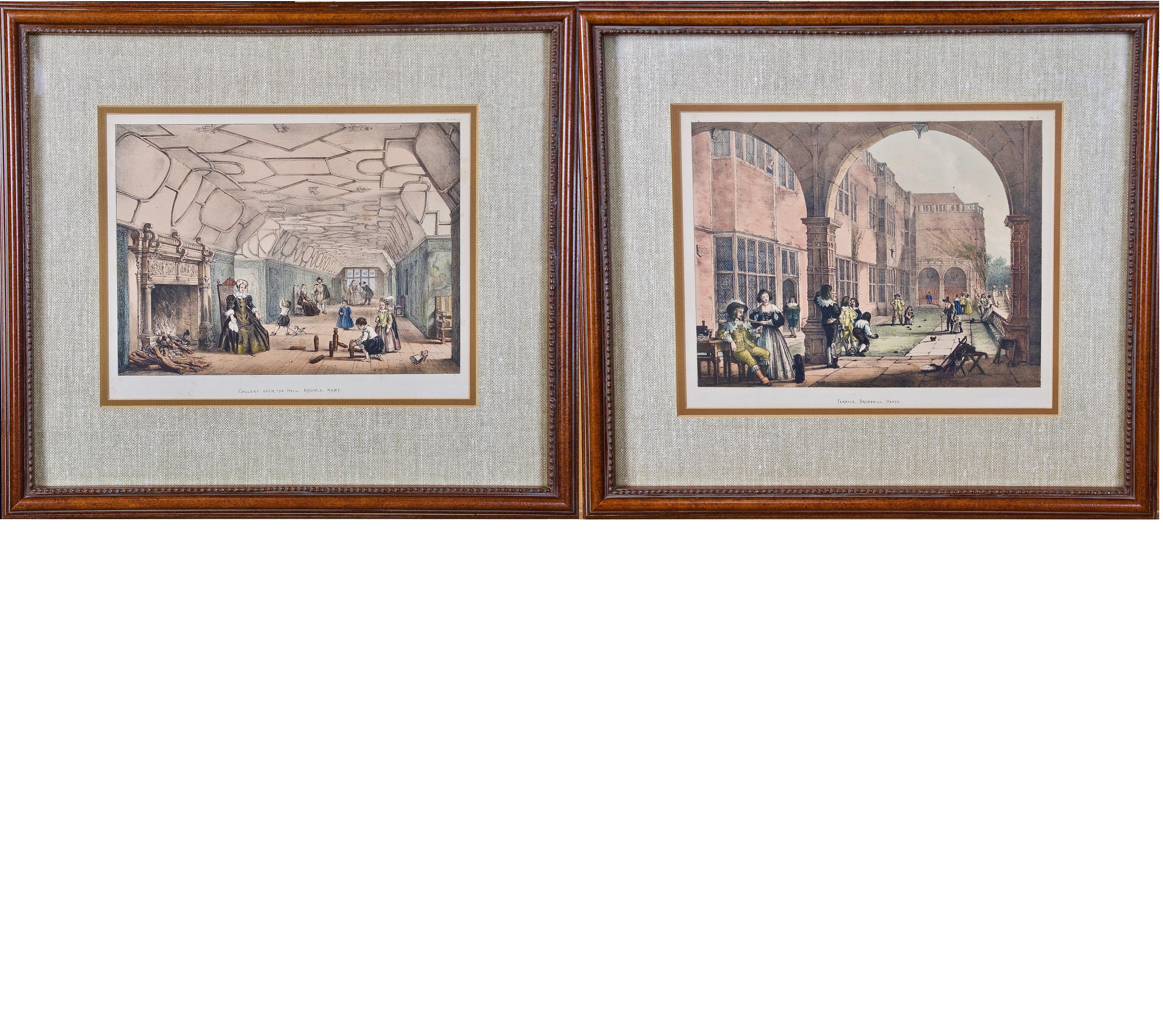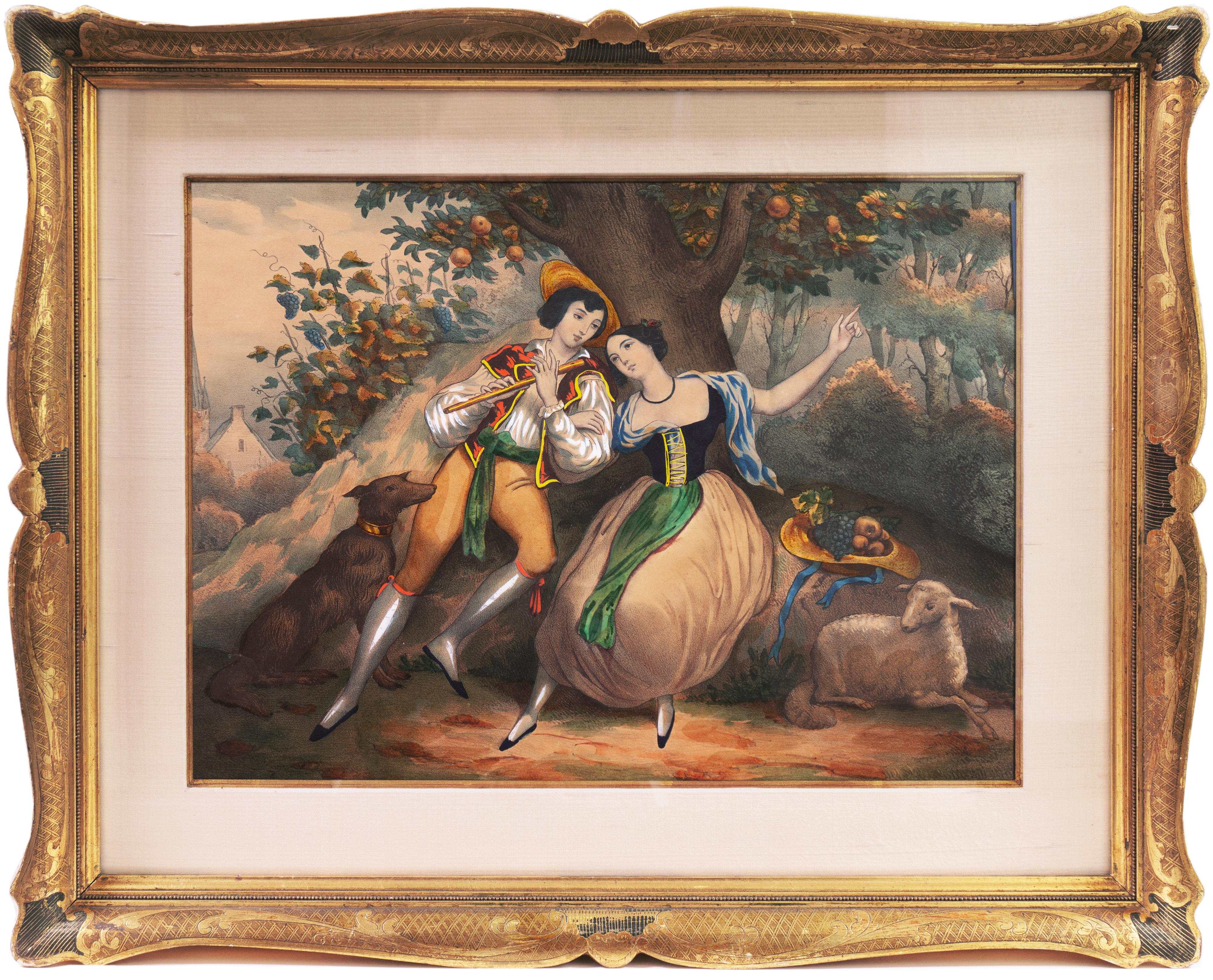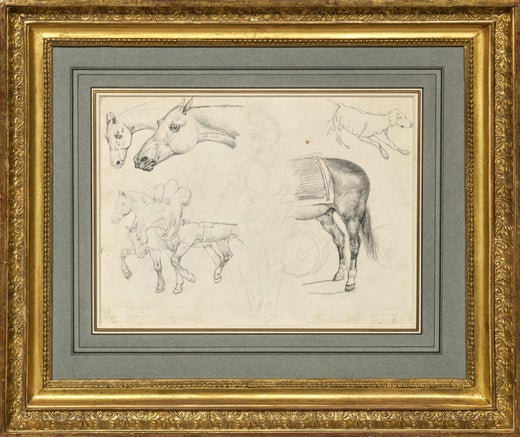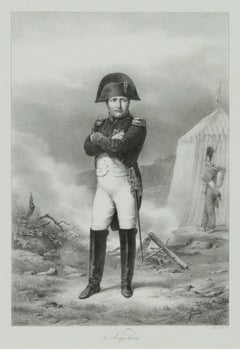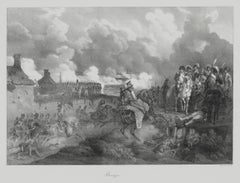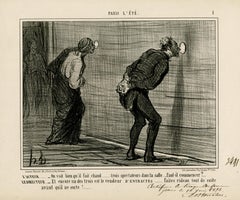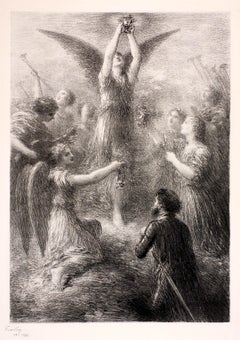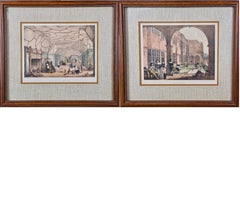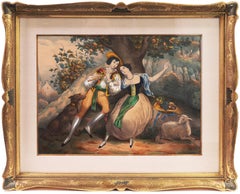Items Similar to Passage du Mont Saint-Bernard
Want more images or videos?
Request additional images or videos from the seller
1 of 11
Jean Louis Andre Theodore GericaultPassage du Mont Saint-Bernard1822
1822
About the Item
Theodore Gericault (1791-1824)
Passage du Mont Saint-Bernard
Lithograph, 1822
Signed and titled in the stone
As published in Arnault "Vie politique et militaire de Napoleon"
Condition: Excellent, aging as expected
Image size: 14 x 161 1/4 inches
Sheet size: 18 7/8 x 24 3/8 inches
Reference: Delteil 44 iv/IV, published state
Théodore Géricault
French painter
Born: September 26, 1791 Rouen France
Died: January 26, 1824 (aged 32) Paris France
Notable Works: “The Charging Chasseur” “The Raft of the Medusa”
Movement / Style: Romanticism
Théodore Géricault, in full Jean-Louis-André-Théodore Géricault, (born September 26, 1791, Rouen, France—died January 26, 1824, Paris), painter who exerted a seminal influence on the development of Romantic art in France. Géricault was a dandy and an avid horseman whose dramatic paintings reflect his flamboyant and passionate personality.
As a student, Géricault learned the traditions of English sporting art from the French painter Carle Vernet, and he developed a remarkable facility for capturing animal movement. He also mastered classicist figure construction and composition under the academician Pierre-Narcissse, Baron Guérin. Another student of Guérin, Eugène Delacroix, was profoundly influenced by Géricault, finding in his example a major point of departure for his own art.
As demonstrated by his earliest major work, The Charging Chasseur (1812), which depicts an officer astride a rearing horse on a smoky battlefield, Géricault was drawn to the colourist style of the Baroque painter Peter Paul Rubens and to the use of contemporary subject matter in the manner of an older colleague, the painter Antoine-Jean Gros. At the Salon of 1814, Géricault’s Wounded Cuirassier shocked critics with its mournful subject and sombre colours. While in Florence and Rome (1816–17), he became fascinated with Michelangelo and Baroque art. His chief project at this time was Race of the Riderless Horse, a heroic frieze composition (never completed) depicting a dangerous race that was an annual event.
After returning to France, Géricault drew a group of lithographs on military subjects that are considered among the earliest masterworks in that medium. Géricault’s masterpiece is the large painting entitled The Raft of the Medusa (c. 1819). This work depicts the aftermath of a contemporary French shipwreck, whose survivors embarked on a raft and were decimated by starvation before being rescued at sea. The shipwreck had scandalous political implications at home—the incompetent captain, who had gained the position because of connections to the Bourbon Restoration government, fought to save himself and senior officers while leaving the lower ranks to die—and so Géricault’s picture of the raft and its inhabitants was greeted with hostility by the government. The work’s macabre realism, its treatment of the raft incident as epic-heroic tragedy, and the virtuosity of its drawing and tonalities combine to give the painting great dignity and carry it far beyond mere contemporary reportage. The portrayal of the dead and dying, developed within a dramatic, carefully constructed composition, addressed a contemporary subject with remarkable and unprecedented passion.
Disappointed by the reception of The Raft of the Medusa, Géricault took the painting to England in 1820, where it was received as a sensational success. He remained there for two years, enjoying the equine culture and producing a body of lithographs, watercolours, and oils of jockeys and horses. Upon his return to France, his friendship with Étienne Georget, a pioneer in psychiatric studies, inspired his series of portraits of victims of insanity, each of whom was seen as a “type” of affliction, including Kleptomania and Delusion of Military Command. Repeated riding accidents and chronic tubercular infections ruined his health, and he died after a long period of suffering.
This article was most recently revised and updated by Amy Tikkanen.
Rich impression
- Creator:Jean Louis Andre Theodore Gericault (1791 - 1824, French)
- Creation Year:1822
- Dimensions:Height: 14 in (35.56 cm)Width: 16.25 in (41.28 cm)
- Medium:
- Movement & Style:
- Period:
- Condition:
- Gallery Location:Fairlawn, OH
- Reference Number:Seller: FA40401stDibs: LU14012363812
Jean Louis Andre Theodore Gericault
Théodore Géricault was born in Rouen in 1791 into a wealthy family from the Manche region. His father, a magistrate and wealthy landowner, ran a tobacco factory. The family moved to Paris around 1796, and in 1810 Théodore Géricault entered Carle Vernet's studio, where he met his son Horace. He then studied with Pierre-Narcisse Guérin before enrolling on February 5, 1811 at the École des Beaux-Arts in Paris, where he pursued a classical training based on copying the masters at the Louvre Museum. Géricault was expelled from the École des Beaux-Arts in 1812 for his misconduct; he then rented a back store on rue de la Michodière, where he painted one of his first masterpieces, a portrait of an officer of the imperial guard (the Lieutenant Dieudonné) charging while on horseback. This painting was exhibited at the 1812 Salon and won him the gold medal at the age of 21! Géricault became a sought-after painter, specializing in military subjects. Géricault falled in love with his aunt Alexandrine Caruel de Saint-Martin (the wife of his mother's brother). Aged 28 years younger than her husband, she was only 6 years older than him. From this affair, which lasted for many years, a son Georges-Hippolyte was born in 1818. After a short engagement in King Louis XVIII's Company of Grey Musketeers, Géricault, disappointed at not winning the Prix de Rome, spent two years in Italy. On his return in 1817, he embarked on the creation of his masterpiece, The Raft of the Medusa, which was exhibited in the Louvre in 1819 and was negatively received by the critics. The presentation of the Raft in London in 1820 brought Géricault to the English capital, first for a two-month period between April and June 1820, then again in 1821 after a return to the continent and a stay in Brussels. The painting was triumphantly received in England (partly for the opposite political reasons to those that had led to its unsuccessful reception in France), and 50,000 visitors flocked to Bullock's gallery where it was exhibited during six months. In November 1821, Géricault returned home very weakened by a venereal disease contracted probably during his stay in England. He fell off his horse several times, and in August 1823 broke his back in a fall. He died at the age of thirty-two on January 24, 1824, after a long agony.
About the Seller
5.0
Recognized Seller
These prestigious sellers are industry leaders and represent the highest echelon for item quality and design.
Platinum Seller
Premium sellers with a 4.7+ rating and 24-hour response times
Established in 1978
1stDibs seller since 2013
786 sales on 1stDibs
Typical response time: <1 hour
Associations
International Fine Print Dealers Association
- ShippingRetrieving quote...Shipping from: Akron, OH
- Return Policy
Authenticity Guarantee
In the unlikely event there’s an issue with an item’s authenticity, contact us within 1 year for a full refund. DetailsMoney-Back Guarantee
If your item is not as described, is damaged in transit, or does not arrive, contact us within 7 days for a full refund. Details24-Hour Cancellation
You have a 24-hour grace period in which to reconsider your purchase, with no questions asked.Vetted Professional Sellers
Our world-class sellers must adhere to strict standards for service and quality, maintaining the integrity of our listings.Price-Match Guarantee
If you find that a seller listed the same item for a lower price elsewhere, we’ll match it.Trusted Global Delivery
Our best-in-class carrier network provides specialized shipping options worldwide, including custom delivery.More From This Seller
View AllNapoleon Standing
Located in Fairlawn, OH
Napoleon Standing
Lithograph, 1822
Signed in the stone lower left corner of image (see photo)
From: Arnault, A. V.
Vie Politique et Militaire de Napoleon (120 plates)
Published, Paris, Librairie Historiquem 1822
Printed by C. Motte, Paris
Considered to be the major pictorial treatise on Napoleon and his military conquests.
Image size: 14 x 9 3/4 inches
Sheet size: 23 5/8 x 17 3/4 inches
Condition: Very good
Horizontal prints...
Category
1820s Romantic Figurative Prints
Materials
Lithograph
Napoleon a Bautzen
By Hippolyte Bellangé
Located in Fairlawn, OH
Napoleon a Bautzen
Lithograph, 1822
Signed in the stone (see photo)
From: Arnault, A. V.
Vie Politique et Militaire de Napoleon (120 plates)
Published, Paris, Librairie Historiquem 1...
Category
1820s Romantic Figurative Prints
Materials
Lithograph
L'ACTEUR . . . . - On voit bien qu'il fait chaud . . . . . . . trois spectateurs
By Honoré Daumier
Located in Fairlawn, OH
L'ACTEUR . . . . - On voit bien qu'il fait chaud . . . . . . . trois spectateurs dans la salle ..... faut-il commencer ? . . . .
LE DIRECTEUR .- Et encore un des trois est le vendeu...
Category
1850s Romantic Figurative Prints
Materials
Lithograph
Prelude de Lohengrin (2e planche) (The Appearance of the Holy Grail)
By Henri Fantin-Latour
Located in Fairlawn, OH
Prelude de Lohengrin (2e planche) (The appearance of the Holy Grail)
Lithograph, 1898
Signed and dated in the stone lower left (see photo)
Printed on chine collee paper
Condition...
Category
1890s Romantic Figurative Prints
Materials
Lithograph
Phrosine and Mélidore
Located in Fairlawn, OH
Phrosine and Mélidore
Etching, 1879
Signed in the polate lower left of image
This etching is after the Dantan painting, a copy after the Pierre-Paul Prud’hom painting
Published by Vv...
Category
1870s Romantic Figurative Prints
Materials
Etching
A Cart Race
By Thomas Rowlandson
Located in Fairlawn, OH
A Cart Race
Hand colored etching & aquatint, 1788
Signed in the plate (see photo)
Published by William Hollande, London
Inscribed in the plate with title, artist's name and publication line 'Rowlandson. 1788./ London. Pubd 1789 by Wm Holland No 50. Oxford Street.'
Reference: M.Dorothy George, 'Catalogue of Political and Personal Satires in the British Museum', VI, 1938)
British Museum Satires 7607
Grego, 'Rowlandson', i. 260, Grego II.392
Provenance: Chris Beetles Ltd., London (label), 2003
Jeffrey M. Kaplan, Washington, D.C.
(label)
Fursten zu Oettingen-Wallerstein, Lugt 2715a,
verso (see photo)
Condition: Excellent
Printed on 18th century laid paper
Archival framing by Chris Beetles Ltd., London
Note: The British Museum has two impressions, one trimmed the other full sheet as this example. Accession Number: 1868,0711.35
The Metropolitan Museum has an impression: Accession number 59.533.314
Fitzwilliam Museum: Accession number: 34.14-286
Cleveland Museum of Art accession number: 1958.10
Image description per BM: Three ramshackle two-wheeled carts drawn by wretched horses race (right to left) against a background formed by the church...
Note: The British Museum has two impressions, one trimmed the other full sheet as this example. Accession Number: 1868,0711.35
The Metropolitan Museum has an impression: Accession number 59.533.314
Fitzwilliam Museum: Accession number: 34.14-286
Cleveland Museum of Art accession number: 1958.10
Image description per BM: Three ramshackle two-wheeled carts drawn by wretched horses race (right to left) against a background formed by the clouds of dust which they have raised, with a row of gabled houses (right) inscribed 'St Giles', terminating in a church spire (left), and probably representing Broad St. Giles. The occupants of the carts are Irish costermongers typical of St. Giles. The foremost horse gallops, urged on by the shouts of a standing man brandishing a club. The other occupants, two women and a man, cheer derisively the next cart, whose horse has fallen, one woman falling from it head-first, another lies on the ground. The driver lashes the horse furiously. The third cart, of heavier construction, is starting. The horses are partly obscured by the clouds of dust, but denizens watch from casement windows and a door. Two ragged urchins (right) cheer the race; a dog barks.
"It was said that the amount of copper Thomas Rowlandson etched would sheathe the British Navy. An inveterate gambler, for much of his life Rowlandson had to produce a flood of his comic prints to stay ahead of financial losses.A wealthy uncle and aunt raised Rowlandson after his textile-merchant father went bankrupt. His career developed quickly. He entered London's Royal Academy Schools in 1772, visited Paris in 1774, exhibited at the Royal Academy in 1775, and won a silver medal in 1777. He left school in 1778 to set up in business. Rowlandson's depictions of life in Georgian England exposed human foibles and vanity with sympathy and rollicking humor. During the 1780s he consolidated the delicate style he used for his coarse subjects. He worked mainly in ink and watercolor, his rhythmic compositions, flowing line, and relaxed elegance inspired by French Rococo art...
Category
1780s Romantic Figurative Prints
Materials
Aquatint
You May Also Like
Woman with Birds
By Sunol Alvar
Located in San Francisco, CA
Artist: Alvar
Title: Woman with Birds
Year: c.1980
Medium: Color lithograph
Paper: Wove
Image size: 18.5 x 24.5 inches
Framed size: 26.5 x 32.65 inc...
Category
Late 20th Century Romantic Figurative Prints
Materials
Lithograph
A Pair of Framed 19th Century Colored Lithographs of Tudor Scenes by Joseph Nash
By Joseph Nash
Located in Alamo, CA
This is a pair of framed 19th century tinted lithographs with hand-coloring entitled "Gallery Over the Hall, Knowle, Kent" and "Terrace Bramshill, Hants" by Charles Joseph Hullmandel (1789-1850) after drawings by Joseph Nash (1809-1878), from "Mansions of England in the Olden Time", published in London in 1839-1849. Nash's publication consists of a series of views of Tudor domestic architecture, which Nash said depicted "the most characteristic features of the domestic architecture of the Tudor Age, and also illustrating the costumes, habits, and recreations of our ancestors." The scenes of the aristocratic ladies and gentlemen (including Henry VIII and Queen Elizabeth I), who are depicted inhabiting the rooms of these great houses, were taken directly from the portraits on the walls.
Charles Joseph Hullmandel, was involved in the creation of these lithographs. He was a famous British lithographer, who invented the "lithotint" process, which he named and patented in 1840. This technique, allowing for greater nuance and value gradation than pure lithography, was an ideal means of expression for Nash's historically rich and picturesque depictions of Tudor mansions and their inhabitants. Hullmandel is also remembered for creating many lithographs from the paintings by J. M. W. Turner.
The "Gallery Over the Hall" depicts a great hall with children playing with skittles (wooden pins resembling bowling pins), a doll and what looks to be a St Charles spaniel, while a lady in Tudor attire watches over them next to a massive stone fireplace. Adults are watching from in the distance while a man bows...
Category
Late 19th Century Romantic Interior Prints
Materials
Lithograph
'Autumn', Hand-colored Lithograph, listening to music under the tree
Located in Santa Cruz, CA
An early twentieth-century, hand-colored lithograph showing an idyllic scene of two young lovers in medieval dress seated in a rural bower beneath fruit...
Category
1920s Romantic Animal Prints
Materials
Lithograph, Paper
Strawberries
By Pati Bannister
Located in San Francisco, CA
This artwork titled "Strawberies" c.1985, published 1996 is a color off set lithograph by British/American artist Pati Bannister, 1929-2013. It is hand signed, titled and numbered 656/950 in pencil by the artist. Published by Masters Publishing INC, New York. The image size is 16.5 x 21 inches, sheet size is 22.25 x 26 inches. It is in excellent condition.
About the artist:
Pati Bannister was born in Highgate, England, overlooking London in 1929. Growing up, both of her parents were artists. Her mother painted watercolor landscapes, while her father painted portraits. To help further her natural talents, she took art lessons as a young girl and ultimately went to work for J. Arthur Rank, the movie maker, as an animator.
At 22 years old, she came to the United States as a governess for a family in Connecticut. Later she became a flight attendant in Florida where she met her future husband, Glynn. Little did she know, he would become the strongest influence in her life as he inspired her to pursue and share her artistic abilities with the public.
In 1958, Pati and Glynn moved to New Orleans and she started painting portraits in Jackson Square. Eventually, she opened two art galleries located in the French Quarter. In the late 1960's, they moved to the Mississippi Gulf Coast...
Category
Late 20th Century Romantic Figurative Prints
Materials
Lithograph
Show and Tell
By Pati Bannister
Located in San Francisco, CA
This artwork titled "Show and Tell" 1999, is a color off set lithograph by British/American artist Pati Bannister, 1929-2013. It is hand signed, titled and numbered 476/950 in pencil by the artist. Published by Masters Publishing INC, New York. The image size is 17.5 x 21 inches, sheet size is 23.25 x 26 inches. It is in excellent condition.
About the artist:
Pati Bannister was born in Highgate, England, overlooking London in 1929. Growing up, both of her parents were artists. Her mother painted watercolor landscapes, while her father painted portraits. To help further her natural talents, she took art lessons as a young girl and ultimately went to work for J. Arthur Rank, the movie maker, as an animator.
At 22 years old, she came to the United States as a governess for a family in Connecticut. Later she became a flight attendant in Florida where she met her future husband, Glynn. Little did she know, he would become the strongest influence in her life as he inspired her to pursue and share her artistic abilities with the public.
In 1958, Pati and Glynn moved to New Orleans and she started painting portraits in Jackson Square. Eventually, she opened two art galleries located in the French Quarter. In the late 1960's, they moved to the Mississippi Gulf Coast...
Category
Late 20th Century Romantic Figurative Prints
Materials
Lithograph
Bridesmaids
By Pati Bannister
Located in San Francisco, CA
This artwork titled "Bridesmaids" 1995, is a color off set lithograph by British/American artist Pati Bannister, 1929-2013. It is hand signed, titled and numbered 41/950 in pencil by the artist. Published by Masters Publishing INC, New York. The image size is 18 x 22.5 inches, sheet size is 23.25 x 26 inches. It is in excellent condition.
About the artist:
Pati Bannister was born in Highgate, England, overlooking London in 1929. Growing up, both of her parents were artists. Her mother painted watercolor landscapes, while her father painted portraits. To help further her natural talents, she took art lessons as a young girl and ultimately went to work for J. Arthur Rank, the movie maker, as an animator.
At 22 years old, she came to the United States as a governess for a family in Connecticut. Later she became a flight attendant in Florida where she met her future husband, Glynn. Little did she know, he would become the strongest influence in her life as he inspired her to pursue and share her artistic abilities with the public.
In 1958, Pati and Glynn moved to New Orleans and she started painting portraits in Jackson Square. Eventually, she opened two art galleries located in the French Quarter. In the late 1960's, they moved to the Mississippi Gulf Coast...
Category
Late 20th Century Romantic Figurative Prints
Materials
Lithograph
